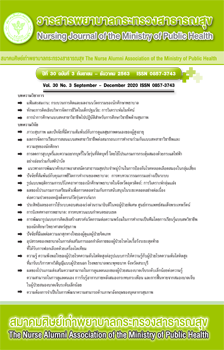Food Consumption Profile among Nursing Students in Uttaradit Province: A Latent Class Analysis
Main Article Content
Abstract
Inappropriate food consumption behaviour may lead to obesity and chronic disease which is resulting in the enormous cost in terms of government control and prevention. Nursing students play an important role as health leaders in promoting health and well-being. The purpose of this study was to examine behavioral food consumption among nursing students and to identify the profile of food consumption behaviour based on nursing student’s perceptions. A descriptive quantitative design was undertaken throughout this study. A total of 323 nursing students was chosen and self-completed questionnaires from the students were obtained. A questionnaire was distributed to students via an email for all students. A latent class analysis was employed to describe profiles of food consumption behaviours among nursing students. The overall food consumption behaviour was moderately appropriate (3.24 ± .42). A three-class model was determined reflecting the different profiles of food consumption behaviour. The largest profile consisted of nursing students likely to consume vegetables, fruit, and clean water (54.1%). Therefore, this study can determine the food behavior and profile of food consumption behaviours among nursing students. In addition, the data can provide the potential for health support policy among nursing students. Specifically, a health promotion program for improving a food consumption behaviour among nursing students by focusing on positive health and well-being should be developed.
Article Details
บทความและรายงานวิจัยในวารสารพยาบาลกระทรวงสาธารณสุข เป็นความคิดเห็นของ ผู้เขียน มิใช่ของคณะผู้จัดทำ และมิใช่ความรับผิดชอบของสมาคมศิษย์เก่าพยาบาลกระทรวงสาธารณสุข ซึ่งสามารถนำไปอ้างอิงได้
References
2. Kunee N. Literature review: the current situation and care model of non-communicable diseases. Nontaburi: Institute of Medical Research and Teachnology Assement;2014.
3. Chaingkuntod S, Mattavangkul C, Junjalearn K, Hongkrailert N, Romnukul N, Udomsri T, et al. Knowledge, attitude, consumers’ behaviors and the media influence on consumers’ behaviors of Phasicharoen persons. Bangkok: The sustainabillty of well-being for Thai people;2013.
4. Social Statistic Division. The 2017 Food Consumption Behavior Survey. In: Social statistic division, National statistical office.2018.
5. Samutachak B, Kanchanachitra M. What drives consumerism in Thai youth? Thammasat journal. 2014;33(1):46-69.
6. Buangam N, Haupsomboon T, Prapalimrangsee P, Boonsong A, Wattanakorn K, Korket S. Factors related to behaviors regarding high cholesterol diets consuming among nursing students. Journal of Prachomklao College of Nursing, Phetchaburi Province.2019;2(1):18-29.
7. Musikthong J, Sriyuktasuth A, Kongkar R, Sangwichaipat N. Nutritional knowledge, attitude towards food, food consumption behavior, and nutritional status in faculty of nursing Mahidol University. Nursing Science Journal of Thailand 2010;28(3):40-9.
8. Sinthukot P, Dolsamer K, Monthawee S, Wongtienlai K, Piaseu N. The relationship between the knowlege and the attitude about food, the health behavior and the nutritional status of the nurse students at Royal Thai Navy College of Nursing. Royal Thai Navy Medical Journal.2019;46(2):336-53.
9. Kongsted A, Nielsen AM. Latent class analysis in health research. Journal of physiotherapy. 2017;63(1):55-8.
10. Maytapattana M. Factors associated with food consumption behavior of nursing students. The Journal of Faculty of Nursing Burapha University.2017;25(3):20-9.
11. Collins LM, Lanza ST. Latent class and latent transition analysis: with applications in the social, behavioral, and health sciences: John Wiley & Sons;2009.
12. Uzhova I, Woolhead C, Timon CM, O’Sullivan A, Brennan L, Peñalvo JL, et al. Generic meal patterns identified by latent class analysis: insights from NANS (National Adult Nutrition Survey). Nutrients. 2018;10(3):310.
13. Maas MK, Bray BC, Noll JG. Online sexual experiences predict subsequent sexual health and victimization outcomes among female adolescents: a latent class analysis. Journal of youth and adolescence.2019;48(5):837-49.
14. Ortíz-Barrios LB, Granados-García V, Cruz-Hervert P, Moreno-Tamayo K, Heredia-Ponce E, Sánchez-García S. The impact of poor oral health on the oral health-related quality of life (OHRQoL) in older adults: the oral health status through a latent class analysis. BMC oral health.2019;19(1):141.
15. Yorlets RR, Iverson KR, Leslie HH, Gage AD, Roder-DeWan S, Nsona H, et al. Latent class analysis of the social determinants of health-seeking behaviour for delivery among pregnant women in Malawi. BMJ global health.2019;4(2):e000930.
16. Chaitokkei S. Factors affecting food consumption behaviors of adults in northeastern Thailand. Research and Development Journal Loei Rajabphat University.2018;13(45):68-78.
17. Nylund KL, Asparouhov T, Muthén BO. Deciding on the number of classes in latent class analysis and growth mixture modeling: A Monte Carlo simulation study. Structural equation modeling: A multidisciplinary Journal.2007;14(4):535-69.
18. Green L, Kreuter M. Health program planning: an educational and ecological approach. 2005. NY: McGraw-Hill Higher Education;2015.

